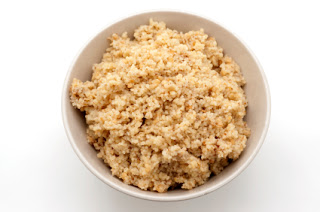( A far prettier version of this post appeared on Blisstree)
I’ll bet my nutrition credentials that broccoli will remain in the good–for-you food group for eternity. Similarly, SPAM and Velveeta will always be unhealthy. Still, many foods aren’t solidly at either end of the health spectrum. And lots of foods that people assume are healthy really aren’t. So, in the hopes of helping you to make smarter eating choices, here are ten foods you may think are healthy and nutritious, but the reality? Not so much
Pretzels
Most pretzels boast no fat and so have a beloved place in many snack drawers. But aside from taste, exactly what do pretzels have to brag about? One ounce of pretzels contains 100 calories and 580 mg of sodium (and little else). Which is almost the same as eating 1 oz. of white hamburger bun: 77 calories and 149 mg sodium. For healthier alternatives, we suggest Happy Herbert’s Gluten Gone Pretzels or our favorite, Food Should Taste Good Chips.
Couscous
Couscous is cute, with its small bead-like shape. And my clients often put it on the “good carb” list with bulgur and other whole grains. I hate to break it to you, but couscous is pasta. The nutritionals are exactly the same. Bulgur and quinoa contain more nutrients.
Veggie Burgers
“Veggie” doesn’t automatically mean healthy. Many veggie burgers are made with TVP (processed soy), grains, and at times, scant amounts of actually vegetables. Scan ingredient labels for TVP and look at the sodium. (Our favorites are Sunshine Burgers.)
Tuna Salad
And now for many people’s treasured tuna salad. Fish contains omega-3’s and we’re told we should consume more of those. However, these particularly omega-3’s have globs of mayo added to them. Four ounces of tuna salad contains 212 calories and 10 grams of fat – double the calories and five times the fat of sliced turkey. We suggest those delicious jarred tunas with chopped peppers, onion and celery, like the Zoe or Tonnino brands.
Brown Sugar
Brown sugar should be healthier than white sugar, right? Unfortunately, it’s not fiber that gives brown sugar its color; it’s molasses. When it comes to calories, brown and white are equals.
Canned Foods/Canned Fruit
My mother was a great cook, but we admittedly ate fruit cocktail growing up. I have two issues with canned fruit: one is the corn syrup pool the fruit swims in, and the other are the BPAs present in the can itself. Fresh fruits are always best, but dried (no sulfites) is my second choice. A medium peach has 8 grams of sugar; while one serving of canned peaches has more than 24 grams (or three times as much).
Olive Oil
Now it’s time to address a food we all know, use, and love: olive oil. We’re actually fine with EVOO (thanks Rachel), but we’re not fine with using it like it’s “free”. It does contain calories, and if you use it to scramble eggs in the morning, in your salad dressing at lunch, and for dunking your bread before dinner (and more to cook your entrée), you’ve racked up almost 1,000 calories – not so healthy. It’s also not recommended to heat olive oil at high temperatures.
Biscotti
We love Italian names, but these are still just cookies. For you cookie monsters, we like healthier options including GlowCookies and Kookie Karma.
UHT (Ultra-Pasteurized) Organic Milk
As we mentioned in an earlier post, organic is a good choice when it comes to dairy, but you need to look carefully at the labels. UHT (ultra pasteurized) milk is not as healthy as regularly pasteurized because the high heat process kills good bacteria and other nutrients. Companies like Organic Valley offer both options, and many including Natural By Nature, Milk Thistle, and our #1, NY Milk always pasteurize at a lower temperature.
Sugar-Free Pudding or Sugar Free Anything.
Sugar-free Pudding (or sugar-free anything) with Splenda or NutraSweet can make brown sugar actually look healthy. We’ll take a little bit of real sugar over the faux version any day.
What were the surprises on this list for you? Any allegedly healthy foods we missed?



Lauren,
Nice list. I’d add:
• “Multigrain”: It means several grains, and has nothing to do with whole grain.
• Most fruit juices: a stripped fruit juice concentrate is, ahem, sugar. Sugar from fruit is no better than sugar from beets or corn. Don’t fall for the “no added sugars” label — fruit juice concentrate IS sugar.
Fruit juice and "fruit snacks" — our parents at school want us to serve those two items to "have healthier choices."
Is couscous ok if it's whole grain?
Great list. There are so many foods that fall into this category. Granola is another one that most people think is healthy, but can be loaded with calories, sugar and fat(stay tuned for a future post). Baked lay's – just b/c it is baked doesn't mean it is good for you. Nothing more than white flour. Spinach or roasted red pepper wraps – nothing more than food dye, no real veggies in them and just because they are thin doesn't mean they are lower in calories. They usually have more calories than 2 slices of bread. Yogurt – so many flavored varieties are loaded with sugar and should be considered dessert.
Thank you for reminding us to think a little more critically before getting into habits. Pretzels are a big one. Sure they are a better choice than potato chips if you're stuck at a vending machine, but that doesn't make them a healthy option on the regular. I also think the canned fruit thing is so sad. A lot of parents think they are doing a good thing by putting something like canned peaches in their kids lunch boxes without realizing their giving them a mid-day sugar high.
I am so surprised to find "Couscous" on the list…
Thanks, Lauren, for stopping by my blog earlier.
I wish you a wonderful and flavouful weekend!
Angie
Hi Lauren,
Great post. I am also a dietitian. Just wondering why you don't recommend ANY sugar-free products. Sure they are artificial, and I personally try to avoid them because of that reason and because I know I can truly use real sugar in moderation. However, for my patients that aren't so great at keeping sugar in moderation, I'm not so sure sugar-free products are a bad thing in terms of helping keep calories down. Can you elaborate on your reason please?
great idea for a post will share 🙂
Ditto from me reg. fruit juice. Nothing healthy about it.
I'm also going to call out most whole grain breads, wraps, crackers, cookies, and buns. Really anything made from whole grain flours. When you pulverize the grain into dust, it digests very quickly even though it is "whole grain." Sure there will be extra vitamins, minerals, and phytonutrients when compared to white bread (although I'm sure some is lost in processing), but the blood sugar effects have to be considered. White bread is actually lower glycemic than whole grain bread, which has a GI in the 70's. Most commercial whole grain products also have lots of additives including sugar and conditioners. A healthier choice is the Food for Life products, which are flourless and made from intact, sprouted grains.
IMO, all grains (whether they are whole/intact or not) should be both portioned control for calories/total carbohydrate and paired with protein/fat to control blood sugar even in "healthy" people.
Oh my such good additions to the faux healthy food list. Susan, I have to say I don't advocate anything with artificial sweeteners such as nutrasweet or Spenda. I believe these actually perpetuate food cravings as the sweet is so intense. And Tands, love Food for Life products most breads, as Melissa pointed out are really crappy (to be frank).
So happy to see Sunshine Burgers are on your "approved" list! I try to eat "from scratch" but keep them handy for those crazy busy weeks. Love them!
Also, great reminder about Olive Oil. I use my Misto to spray oil so that I'm not pouring it on but I should probably be more aware of how much I'm eating on a daily basis.
Great article Lauren!
I would add omega-3 fortified foods. Often, they are fortified with ALA, the plant-based omega-3. This must be converted in our bodies to DHA (the fish-based omega-3) in order for us to use it. However, this process, from ALA to DHA, is not efficient and only 20% ends up converted. Not a very good deal.
This is great list/article Lauren! Thanks for the reminder for olive oil and reminding me the 'healthy' things to eat and look for!
A practical post packed with nutritious information. I love that you not only tell us what isn't healthy, but that you list healthier alternatives. A post to bookmark and come back to.
Ty for such a great reminder that just because the box list SF or FF it does not always mean it's healthy.
This is an excellent post and I think that it is always beneficial to uncover some of the things that people just assume are healthy. There are hidden fats, preservatives and sugars in many of the foods that are advertised to us as being healthy but in actual fact they are not.
I enjoyed reading this.
I agree with the tuna salad issues (or egg salad, chicken salad, etc). But, there are ways to make these things a little better for you – you can use light mayo, or just less mayo, and I usually supplement the mayo with mustard to give it more flavor anyway. (Whenever I order tuna salad out somewhere, it always has WAY too much mayo for me, I prefer a drier tuna salad.) Or, a good alternative to mayo is plain greek yogurt (fat free or lowfat). It tastes pretty good and the consistency is really good.
There are hidden fats, preservatives and sugars in many of the foods that are advertised to us as being healthy but in actual fact they are not. This was a great post.